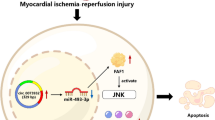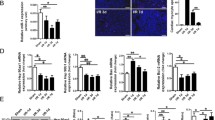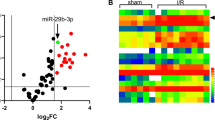Abstract
Growing evidence indicates that aberrant upregulation of microRNA-1 (miR-1) occurs in ischemic myocardium. In addition, insulin elicits metabolism-independent cardioprotection against cardiovascular diseases. The aim of this study is to determine whether insulin ameliorates miR-1-induced injury in H9c2 cells under oxidative stress and to investigate the underlying mechanisms. By quantitative real-time RT-PCR (qRT-PCR), we show that miR-1 is upregulated in H9c2 cells after treatment with hydrogen peroxide (H2O2), and this effect is both dose- and time dependent. Furthermore, expression of miR-1 decreased significantly after insulin treatment (4.5 ± 0.1 vs. 3.0 ± 0.2, p < 0.05). To determine the potential role of miR-1 in cellular injury and gene regulation, adenovirus-mediated overexpression of miR-1 was used. Overexpression of miR-1 decreased cell viability by 28 ± 2 % (n = 6, p < 0.05) and damaged Akt activation with or without H2O2 treatment. To further investigate the effect of the phosphatidylinositol 3-kinase (PI3K)/Akt pathway in miR-1-induced injury, H9c2 cells were pretreated with LY294002 (10 μM LY, a specific inhibitor of PI3K) with or without insulin (100 nM) and subjected to H2O2 treatment. LY pretreatment-inhibited Akt activation, lead to increased reactive oxygen species (ROS), and further decreased cell viability induced by miR-1 (n = 6, p < 0.05, n = 9–10 cells/group, p < 0.05 and n = 6, p < 0.05) under oxidative stress. This effect was abolished by insulin. In summary, our findings suggest that miR-1expression is sensitive to H2O2 stimulation. In addition, insulin decreases miR-1 expression and induces a marked protective effect on miR-1-induced injury under oxidative stress, which may be mediated by the Akt-mediated pathway. These results provide an important, novel clue as to the mechanism of the cardiovascular action of insulin.




Similar content being viewed by others
References
Wang Z (2010) MicroRNA: a matter of life or death. World J Biol Chem 1(4):41–54
Rao PK, Kumar RM, Farkhondeh M, Baskerville S, Lodish HF (2006) Myogenic factors that regulate expression of muscle-specific microRNAs. Proc Natl Acad Sci USA 103(23):8721–8726
Tang Y, Zheng J, Sun Y, Wu Z, Liu Z, Huang G (2009) MicroRNA-1 regulates cardiomyocyte apoptosis by targeting Bcl-2. Int Heart J 50(3):377–387
Shan ZX, Lin QX, Fu YH, Deng CY, Zhou ZL, Zhu JN, Liu XY, Zhang YY, Li Y, Lin SG, Yu XY (2009) Upregulated expression of miR-1/miR-206 in a rat model of myocardial infarction. Biochem Biophys Res Commun 381(4):597–601
Xu C, Lu Y, Pan Z, Chu W, Luo X, Lin H, Xiao J, Shan H, Wang Z, Yang B (2007) The muscle-specific microRNAs miR-1 and miR-133 produce opposing effects on apoptosis by targeting HSP60, HSP70 and caspase-9 in cardiomyocytes. J Cell Sci 120(Pt 17):3045–3052
Ai J, Zhang R, Li Y, Pu J, Lu Y, Jiao J, Li K, Yu B, Li Z, Wang R, Wang L, Li Q, Wang N, Shan H, Yang B (2010) Circulating microRNA-1 as a potential novel biomarker for acute myocardial infarction. Biochem Biophys Res Commun 391(1):73–77
Cheng Y, Liu X, Zhang S, Lin Y, Yang J, Zhang C (2009) MicroRNA-21 protects against the H(2)O(2)-induced injury on cardiac myocytes via its target gene PDCD4. J Mol Cell Cardiol 47(1):5–14
Brewer AC, Shah AM (2009) Redox signalling and miRNA function in cardiomyocytes. J Mol Cell Cardiol 47(1):2–4
Hausenloy DJ, Yellon DM (2007) Reperfusion injury salvage kinase signalling: taking a RISK for cardioprotection. Heart Fail Rev 12(3–4):217–234
Yu Q, Gao F, Ma XL (2011) Insulin says NO to cardiovascular disease. Cardiovasc Res 89(3):516–524
Bertrand L, Horman S, Beauloye C, Vanoverschelde JL (2008) Insulin signalling in the heart. Cardiovasc Res 79(2):238–248
Li J, Wu F, Zhang H, Fu F, Ji L, Dong L, Li Q, Liu W, Zhang Y, Lv A, Wang H, Ren J, Gao F (2009) Insulin inhibits leukocyte-endothelium adherence via an Akt-NO-dependent mechanism in myocardial ischemia/reperfusion. J Mol Cell Cardiol 47(4):512–519
Mullonkal CJ, Toledo-Pereyra LH (2007) Akt in ischemia and reperfusion. J Invest Surg 20(3):195–203
Granjon A, Gustin MP, Rieusset J, Lefai E, Meugnier E, Guller I, Cerutti C, Paultre C, Disse E, Rabasa-Lhoret R, Laville M, Vidal H, Rome S (2009) The microRNA signature in response to insulin reveals its implication in the transcriptional action of insulin in human skeletal muscle and the role of a sterol regulatory element-binding protein-1c/myocyte enhancer factor 2C pathway. Diabetes 58(11):2555–2564
Fiordaliso F, Bianchi R, Staszewsky L, Cuccovillo I, Doni M, Laragione T, Salio M, Savino C, Melucci S, Santangelo F, Scanziani E, Masson S, Ghezzi P, Latini R (2004) Antioxidant treatment attenuates hyperglycemia-induced cardiomyocyte death in rats. J Mol Cell Cardiol 37(5):959–968
Wang Z, Cui M, Sun L, Jia Z, Bai Y, Ma K, Chen F, Zhou C (2007) Angiopoietin-1 protects H9c2 cells from H2O2-induced apoptosis through AKT signaling. Biochem Biophys Res Commun 359(3):685–690
Han M, Toli J, Abdellatif M (2011) MicroRNAs in the cardiovascular system. Curr Opin Cardiol 26(3):181–189
Yang B, Lin H, Xiao J, Lu Y, Luo X, Li B, Zhang Y, Xu C, Bai Y, Wang H, Chen G, Wang Z (2007) The muscle-specific microRNA miR-1 regulates cardiac arrhythmogenic potential by targeting GJA1 and KCNJ2. Nat Med 13(4):486–491
Glass C, Singla DK (2011) ES cells overexpressing microRNA-1 attenuate apoptosis in the injured myocardium. Mol Cell Biochem 357(1–2):135–141. doi:10.1007/s11010-011-0883-5
Yang B, Lu Y, Wang Z (2008) Control of cardiac excitability by microRNAs. Cardiovasc Res 79(4):571–580
Elia L, Contu R, Quintavalle M, Varrone F, Chimenti C, Russo MA, Cimino V, De Marinis L, Frustaci A, Catalucci D, Condorelli G (2009) Reciprocal regulation of microRNA-1 and insulin-like growth factor-1 signal transduction cascade in cardiac and skeletal muscle in physiological and pathological conditions. Circulation 120(23):2377–2385
Liu X, Pan L, Gong Q, Zhu Y (2010) Leonurine (SCM-198) improves cardiac recovery in rat during chronic infarction. Eur J Pharmacol 649(1–3):236–241
Acknowledgments
This work was partly supported by the National Basic Research Program of China (973 Program: No. 2012CB51780X), National Science Fund for Distinguished Young Scholars (81025002 to Z.Y.), and Natural Science Foundation of China (30871043 to Z.Y.).
Author information
Authors and Affiliations
Corresponding authors
Rights and permissions
About this article
Cite this article
Chen, T., Ding, G., Jin, Z. et al. Insulin ameliorates miR-1-induced injury in H9c2 cells under oxidative stress via Akt activation. Mol Cell Biochem 369, 167–174 (2012). https://doi.org/10.1007/s11010-012-1379-7
Received:
Accepted:
Published:
Issue Date:
DOI: https://doi.org/10.1007/s11010-012-1379-7




